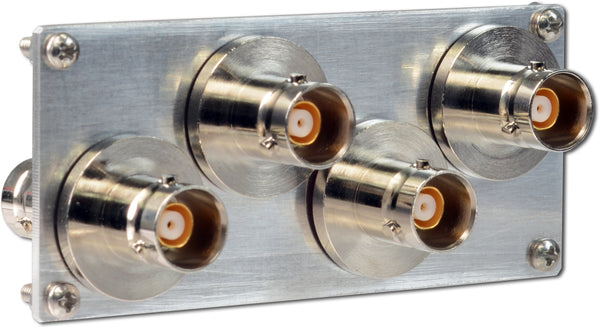Applications:
|
|
Features:
|
|
DescriptionThe PRL-4520 is 2 x 1:8 logic level translator and fanout buffer with two LVDS Triax inputs and sixteen 50 Ω TTL/SMA outputs. It is designed for translation and distribution of high-speed clock and trigger signal to multiple loads via long lines, especially the synchronous clocking/triggering of Dalsa X64 Xcelera-HS PX8 and similar framegrabbers. The 50 Ω back-terminated outputs can drive long lines with or without 50 Ω load terminations. With 50 Ω load terminations, however, all outputs of the PRL-4520 can drive 100 ft of 50 Ω cables at clock rates greater than 50 MHz. Each input channel of the PRL-4520 has a differential 100 Ω LVDS Triax input and eight 50 Ω back terminated TTL SMA outputs, which typically deliver 2.5 V into 50 Ω or 5.0 V into Hi-Z loads. A valid signal LED indicator is provided for each channel. All I/Os are DC coupled. An equivalent circuit of the PRL-4250 LVDS input is shown in Fig. 1, and the internal signal fanout and distribution block diagram is shown in Fig. 2. The PRL-4250 is housed in a standard 1U, 19” rackmount enclosure. External 8V/12V, 2A DC power is required. The PRL-4520 may be with ordered with a custom silkscreen, which case the model would be identified as PRL-4520-C00x, where each configuration would have a unique suffix, but all PRL-4520 units will have the same form factor and electrical function. |


(0° C ≤ TA ≤ 35° C)*
| Symbol | Parameter | Min | Typ | Max | Unit | Comments |
|---|---|---|---|---|---|---|
| RIN | Input Resistance | 95 | 100 | 105 | Ω | Floating differential |
| ROUT | Output Resistance | 50 | Ω | |||
| VIA | Non-Inverting Input | 0 | 2.5 | V | Fig. 1 | |
| VIB | Inverting Input | 0 | 2.5 | V | Fig. 1 | |
| VID | Differential Input | 35 | 100 | mV | Fig. 1 | |
| VIC | Common Mode Voltage | 0 | 1.2 | 3.0 | V | VIC=(VIA+VIB)/2 |
| VOL | TTL Output Low Level | 0.0 | 0.25 | 0.5 | V | RL=50 Ω |
| VOH1 | TTL Output High Level | 2.2 | 2.5 | V | RL=50 Ω @ DC | |
| VOH2 | TTL Output High Level | 4.4 | 5.0 | V | RL=1 MΩ @ DC | |
| IDC1 | DC Input Current | 1256 | mA | f = 85 MHz, 8 outputs loaded(1) | ||
| IDC2 | DC Input Current | 1354 | mA | f ≤ 85 MHz, 10 outputs loaded | ||
| IDC3 | DC Input Current | 1080 | mA | f ≤ 50 MHz, 10 outputs loaded | ||
| VDC | DC Input Voltages | 8.0 | 8.5 | 12.0 | V | |
| TPLH | Propagation Delay to output ↑ | 17 | 21 | ns | ||
| tr | Rise Time (10%-90%) | 1.8 | 2.5 | ns | ||
| tf | Fall Time (10%-90%) | 1.5 | 2.5 | ns | ||
| TSKEW1 | Skew between any 2 outputs | 0.5 | 1.5 | ns | Within same bank | |
| TSKEW2 | Skew between any 2 outputs | 1.0 | 3.0 | ns | Within same unit | |
| FMAX1 | Max. Clock Frequency(2) | 80 | 90 | MHz | Driven by PRL-426NTR | |
| FMAX2 | Max. Clock Frequency | 50 | RG58C/U, cable length = 100 ft | |||
| PWMIN1 | Minimum Pulse Width | 4 | ns | ↑ Input | ||
| PWMIN2 | Minimum Pulse Width | 6 | ns | ↓ Input | ||
| DC input connector | TE/Amp 350778-1 | Or equivalent | ||||
| Size | 18.95 W x 1.75 H x 10.5 | Depth from rack face | ||||
| Weight | 1.5 | lb | ||||
Notes:
- fMAX should not exceed 125 MHz, otherwise damage of the unit due to overheating may result.
- fMAX2 is measured by driving a PRL-4110 at the end of a 100 ft cable.






